The Irish Volunteers at the Vanderbilt Cup Races
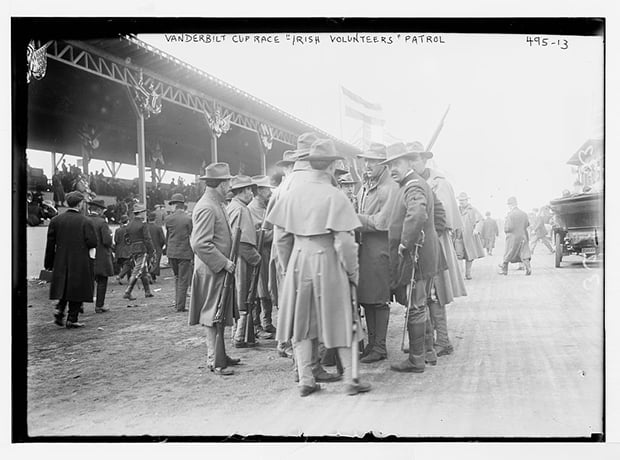
In honor of St. Patrick's Day last Sunday, here's a Long Island St. Patrick's Day Story by Paul R. Martin III:
Beneath the Shadows of Wings
Untold Stories from Mitchel Field: Vol I-1908-1920
The Irish Volunteers, The Vanderbilt Cup, and the Hempstead Plains
- Text: Copyright 2024: by Paul R. Martin III
- Photos: Detroit Public Library
Greg O.

An excerpt from;
Beneath the Shadow of Wings
Untold Stories from Mitchel Field: Vol I-1908-1920
By Paul R. Martin III
"Long Island History recorded the encampment of the famed Irish Brigade’s “Fighting 69th” Regiment at Camp Mills before departing for France during WWI. They were memorialized in the well-known 1940 Warner Brothers film, “The Fighting 69th”, which starred James Cagney as Jerry Plunkett and Pat O’Brian as Father Francis Duffy. Filmed in the Providencia Ranch, the obvious mountain background of the Hollywood Hills belied the flat open spaces of the Hempstead Plains. Released just before the outbreak of WWII, the popular film brought Camp Mills, the Hempstead Plains, and Long Island into the hearts and minds of men and women all across America. But just ten years before training began at Camp Mills in 1917, their ancestors left their mark upon the Hempstead Plains in a lesser-known peacetime endeavor, climaxed by a religious observance rivaling the historic ceremony at Gettysburg during the Civil War.
It all revolved around the William K. Vanderbilt Jr. Cup Auto Race, first run in 1904, that covered 30 miles of public roads across central Long Island. As its popularity increased, so did the number of spectators mobbing the tight shoulder aside the narrow roadways. By 1906 more than 200,000 people descended upon the course to watch their favorite drivers. The death of a spectator that year compelled Vanderbilt to re-consider the public road course, and he proposed a private, modern concrete racetrack designed specifically for high-speed motor car racing. Long Island Motor Parkway Incorporated was founded in December of 1906 to oversee and build the project. Difficulty obtaining rights of way on private property, or outright purchases, hindered the construction start of the ambitious Queens to Lake Ronkonkoma roadway. The setbacks forced the cancellation of the race in 1907.
The recommencement of the popular race after the one-year hiatus, the increased speed of the course, and the coincidental annual encampment of the Irish Volunteers that year, set into motion an extraordinary event on the Hempstead Plains in the fall of 1908.
The “Irish Volunteers” were “an independent military organization which has held a state charter since 1860”, and “is one of the few semi-military organizations in this country authorized to carry arms, and has been in existence since 1860, when it was known as the Thomas Francis Meagher’s Irish Brigade”. Direct descendants of the 69th New York State National Guard (Militia), they formed a rear-guard in Washington during the First Battle of Bull Run at the outset of the Civil War. After 90 days, they were re-enrolled as the 69th New York Volunteer Infantry Regiment into General Thomas Francis Meagher’s famous Irish Brigade, mustered into the Union Army in 1861. The Regiment fought fearlessly at the Seven Days battles and Malverne Hill where after leading a ferocious charge against Confederate troops, Gen. Robert E. Lee nicknamed them The Fighting 69th. The gallant sons of Erin fought courageously again at Antietam, Fredericksburg, and Chancellorsville. Their vastly diminished personnel from the previous battles still held strong against superior numbers in the bloody Wheatfield at Gettysburg. Their depleted ranks merged with other Irish units in the 2nd Irish Brigade and were present at General Lee’s surrender in Appomattox in April 1865. Following the Washington DC Grand Review of the Armies in May, they returned to New York City to become part of the New York National Guard.
Several re-organizations occurred throughout the late 1800s until they were mustered into Federal service again on May 19, 1898, at Camp Black, Hempstead Plains, New York, as the 69th New York Volunteer Infantry, where they stood ready for duty in the Spanish American War. When a third call for volunteers did not occur, many men and officers enlisted in other organizations destined for the front. The regiment mustered out of Federal service January 31, 1899, at New York before reorganized on March 15, 1899, into the New York National Guard in New York City as the 69th Infantry Regiment where they fought in WWI and WWII. From its armory on Lexington Avenue, they secured Ground Zero following the September 11 attacks. They served in Operation Iraqi Freedom and Afghanistan and continue to serve their nation to this day.
The unusual status of the Volunteers in 1908 was described by the Army Navy Times. “The Irish Volunteers is an organization supported largely by lodges of the Clan-na-Gael, but the members also pay dues. It is not a state force in any sense, and really parades with arms, contrary to law. It appears that each succeeding governor has dodged the matter of enforcing the law concerning the existence of illegal military organizations. The volunteers do no harm, however, and the British government at last accounts, had no fear of an invasion of Ireland by the bold volunteers…”.
Commander, Colonel Charles J. Crowley stopped into the Garden City Hotel on Friday afternoon October 16 after reconnoitering the Hempstead Plains for his regiment’s upcoming week-long training encampment. Perhaps it was the luck of the Irish that he happened to meet Jefferson DeMont Thompson and A. R. Pardington of the Vanderbilt Cup Commission while dining at the hotel. In their discussion, “Crowley remarked that during the week of the race his brigade would hold its annual encampment on Hempstead Plains”. The commissioners explained their inability to get regular troops to guard the course, since “Governor Hughes said it would be improper for him to assign state troops for police duty of this character, and President Roosevelt took a similar stand regarding troops from the army”. They suggested to Crowley for the regiment to provide crowd control for the Saturday race.
Crowley realized “it would be a good plan to drill his men in riot duty at the same time.” He quickly agreed to accept the assignment, “not only in the interest of protecting life at the big race, but also to give the men an opportunity to see the race and to have a little experience in handling an enthusiastic crowd.” Following phone discussions with his staff, “arrangements were made to prepare the brigade for encampment on Thursday morning.” (October 22)
The camp site selected for the troops was along the old country road, west and south of the village of Hicksville on a large open field indicative of those that made up the expansive Hempstead Plains. (Near the Salisbury area between Westbury and Hicksville.) The property was owned by the Parkway Corporation and had been surveyed by them for the parkway construction project.
“Rations were ordered for six hundred men. Tents will be pitched on Thursday morning and the brigade will go into camp on Thursday Afternoon. On Friday morning there will be extended order drills and on Saturday morning, October 24, the day of the race, reveille will be sounded at 3:30 o’clock. The men will proceed in heavy marching order, with Springfield rifles and bayonets to the following points: Jericho Corners, Westbury, Locust Grove, Plain View, Bethpage, Woodbury, and the grandstand.” The grandstand was built on the plains in the vicinity of modern Levittown, between Orchid Lane and Woodcock Lane, west of Crocus Lane. The full course encompassed 23.46 miles, combining the nine miles of new track with 14.45 miles of existing public roads.
“The various detachments assigned to those points will be under company commanders… and the men will patrol the course between those different points” . Their task was simple: keep the roadway clear of spectators. “They are all matured men, most of them being Spanish War veterans, and they are sufficiently athletic to handle any gentleman who desires to stand out in the middle of the road for the purpose of being killed”. The increased speed of the new racing cars and the long stretches of concrete roadway created more danger for the onlookers, especially those who crowded too close to the edge. “The volunteers are uniformed and carry rifles, so that their presence probably will prevent enthusiastic spectators from committing suicide in front of racing machines”. Organizers hoped the mere sight of the well-trained Irish Volunteers would keep the crowds at bay.
“Colonel Crowley will give orders to use diplomacy, as a rule, and good old-fashioned Irish American methods when necessary. Of course, the Springfield rifles will probably not be loaded. It is believed that the very presence of the uniformed troops with arms will have a deterring effect upon the persons who have in former years been so unruly and have refused to obey the requests of the deputy sheriffs to keep back and give the racing cars a chance to get through”.
Both commands totaled 800 men; 600 Irish troopers and 209 Deputies. The entire force fell under command and direction of Nassau County Sheriff Joseph H. Foster, “as the volunteers have been sworn in by him as special deputies for tomorrow”.
Upwards to a half a million people were expected to watch the race. They began trickling into local environs and New York City hotels at the end of the preceding week. “New York is almost overrun with motorists and the big hotels at which out-of-town automobile lovers patronize are filled to overflowing. Half a dozen of the big uptown hotels announced this morning that standing room only is at a premium and all the vacant spaces about the hotels are filled with motor cars, the regular garages having overflowed. Some have come hundreds of miles in their cars”.
“At 3 o’clock in the morning the big crowd began to arrive from New York and the number of spectators has been steadily increasing ever since”. “Never before in the history of the sport have so many automobiles invaded peaceful and placid Long Island, as crossed over tonight”.
By the break of dawn 200,000 auto race enthusiasts spilled over “the few square miles of country encompassed within the Long Island country roads and the new motor parkway over which tomorrow’s Vanderbilt race is to be run”.
From away in the distant darkness drifted the stately sounds of a military band, echoing ominously across the plains. “It was martial music, well suited to the battle sounds of the volleying racers”.
“The band reached the stand at the head of the Irish Volunteers, 600 strong, armed and uniformed as if for war”. Companies were deployed to their assigned stations to regulate the crowds. “The Irish Volunteers were entirely different from the undisciplined mob of soldiers that tried to police the Briarcliffe course. No bayonets were permitted on the guns, as it was thought that a judicious punch in the ribs with the muzzle of a gun would be sufficient to move obdurate interlopers. The soldiers started in to clear the crowd away and succeeded so far as the course near the grandstand was concerned. At other parts of the course the crowd made it almost impossible for racers to get through” George Robertson lodged a formal complaint to the organizers before the start, anticipating the unruly mobs would make it difficult “to drive fast without killing dozens of persons”.
“The amateur soldiers of the Irish Volunteers Regiment, looking very businesslike as they leaned on their Springfield rifles, had already taken their places around the course when the first cars arrived and the first trains unloaded their eager, struggling human freight. With them…stood the deputy sheriffs of Nassau County, a resolute body for the protection of life and the maintenance of order”. A light early morning rain dampened the course and spectators who filled the grandstand as the cars, drivers and mechanicians took their places in the pit area. “Cloaked officers of the Irish Volunteers strode proudly about with drawn swords, looking much more important than anything else in the race.”
“W. K. Vanderbilt, Jr., the donor of the trophy, attended by starter Fred Wagner and Chairman Thompson of the racing board, assumed management and the Irish Volunteers cleared the course in quick time. By this time all the racers were in line awaiting the word”.
Scheduled to begin at 6 AM, October 24, the start was pushed back to 6:30, mostly because it was still dark. In the continuing drizzling rain, the cars formed at the start/finish line at the center of the grandstand. “Seventeen coughing, snapping cars lined up, and sixteen went off with a succession of pistol-shot explosions at 6:30 AM”. Lewis Strang’s Renault broke down almost immediately and was pushed aside, never getting into the race.
The volunteers’ mission to maintain crowd control was doomed from the start by overwhelming circumstances and poor planning on the part of race organizers. “The Vanderbilt Cup Commission failed to take advantage of its opportunities, either from indifference or inefficiency, and it marred what might otherwise have been a most notable contest”. Armed with guns, but no real authority, certainly hindered the guards’ effectiveness, as did the overwhelming number of spectators the small unit was expected to control. “The Irish Volunteers no doubt did all that so many men could have done to keep the road clear; but the guard was a sham, and as such made no impression on the people it sought to control.”
“The Irish Volunteers who were supposed to keep the crowd back, with the assistance of hundreds of deputy sheriffs and constables, were next to useless for they lacked the power to make an arrest”. The men had their hands full. Close to 250,000 people jammed the course with the greatest number about the grandstand area and the entrances to the new motor parkway section. “The Irish Volunteers who patrolled the course had little opportunity to keep it clear from the Westbury turn to the Motor Parkway entrance, for the crowd behaved well there. The volunteers handled the crowd admirably at the bridge that crosses the railroad near the parkway entrance, but it was generally believed that had the soldiers been concentrated at the Westbury turn, instead of being strung out along the course on either side of the turn, the persistent crowd of track blockers would have kept in place”.
The large crowds entered the course area early and lined both sides of the roadway. “When the guards arrived, it would have been impossible for ten times their number to have cleared the track”. The difficulty the volunteers faced to keep the road clear, and the drivers attempts to avoid spectators, was evident early on at the Westbury turn. “Not withstanding the fact that the turn was roped off, many women as well as men closed into the center of the roadway at the shout of ‘car coming’!” Similar scenarios repeated themselves the entire length of the 25-mile course and during all eleven laps completed throughout the race.
George Robertson won the race in an all-American Locomobile, completing the 11 laps of 23.46 miles each at an average speed of 64.3 miles an hour in four hours, 48 1/2 minutes. (258.06 miles total)
Even while the volunteers and deputies tried to maintain some sense of order at the more distant and less crowded locations, they could not hold back the thousands of enthusiastic patrons who rushed the motor cars at the conclusion of the race. Chaos ensued. “When the great race was won by the American driver the multitude broke all bounds. It swarmed out into the course from field and grandstand, sweeping back the military patrol and the phalanx of deputy sheriffs like chaff before a gale. It broke down the wire fences and surged forward relentlessly, carrying with it Major Charles J. Crowley’s uniformed guards of the Irish Volunteers, who had come from their neighboring camp on Hempstead Plains to do police duty over the course.”
“It swallowed up the guards as chips are sucked into a vortex of a whirlpool and in a moment a compact mass of yelling, cheering enthusiasts had overrun the stretch, covering the concrete parkway solidly from the grandstand on the side to the official pavilion of the judges, timers and reporters on the other. And in the center of the human maelstrom, Robertson sat in his dun-colored locomobile, wiping the soot from his begrimed face. The crowd pressed around his car, fighting to be the first to grasp his hand. They climbed upon its tires and its radiator, and at last he had to yield to the nearest dozen, who swept him boldly out of his seat and carried him aloft in triumph”.
Oblivious to the danger about to overtake them, the crowd did not hear the shouts of warning from the judges stand as the second place Isotta-Fraschini vehicle, driven by Herbert Lytle, barreled into the straightaway. “Again, the megaphone shrieked a warning… There was a struggle to force a narrow pathway for the onrushing car, but a big red touring machine had encroached on the course as the lines were swept away and the mass of men and boys was congested about it so tightly that it obstructed the rush for safety”.
Just a few minutes later Vanderbilt ordered the race stopped, “to save the lives of hundreds in the crowd who swarmed out on the course about the grandstand in suicidal frenzy”. Telephone calls were rushed to every point along the course, but two vehicles sped past the white flags frantically waving from the Meadowbrook toll lodge.
Jim Florida’s locomobile hurtled toward the dense mob. He swerved into a small open space, crashed into a touring car, and pinned a young man between the two vehicles. Eighteen-year-old David Schuh suffered a broken leg and was removed to Nassau Hospital. Schuh was the only person injured because of the race proper, although four men were slightly injured when their touring car steering gear failed and crashed into a tree opposite William Pickering’s store in Roslyn.
William Luttgen, driving Vanderbilt’s Mercedes came barreling through the grandstand logjam next. Miraculously, weaving and swerving, he “went through the danger zone without hitting anyone, by a display of the most consummate skill”.
Vanderbilt and the directors were highly criticized for the inadequate logistics, organization, and poor planning of the race. “Gratifying as the victory of an American car in the big American classic road race of the year is, the Vanderbilt Cup race of 1908 in retrospect falls far short of expectations”. The race was held on Long Island again in 1909 and 1910. The death of two mechanics and several spectator injuries in 1910, and the outcry that followed led to the race’s demise. “After 6 years of controversy that accompanied each race, the sport had outgrown the venue. The two deaths from the 1910 contest effectively put an end to road racing on Long Island”.
For the Irish Volunteers the mission was considered a success and achieved Colonel Crowley’s objectives. The encampment was given specific purpose, the men gained crowd and riot control experience, and were rewarded with the opportunity to witness a great American event.
Their whole experience culminated on Sunday morning with a grand, majestic spectacle; “An impressive military mass was celebrated on the Hempstead Plains for the Irish Volunteers, who had been camped on the plain for three days and who had done such effective service regulating the great Vanderbilt competition on Saturday.”
The scene was reminiscent of the great Absolution ceremony bestowed upon the men of the Irish Brigade by Father Corby, as they knelt in prayer on the Weikert Farm at Gettysburg, mere moments before charging into glory through shot and shell in the Wheatfield and up the Stoney Hill on the second day’s battle.
“The chapel tent, draped in flags, and the priest on the alter in his brilliant vestments, made striking color in the morning sun. Along the lines of blue-coated, kneeling men, every face was grave, every head bowed. The stillness of the devotion at mass was broken at the elevation, the moment when the priest raised aloft the sacred host. The soldiers rose as one, the buglers sounded Gloria, the officers in front drew their swords and held them at salute. Then as the celebrant slowly lowered the host, arms were grounded.”
Following the mass, the men dispersed to begin dismantling their temporary quarters. “The regiment broke camp at sundown and came back to New York in a special train”. A gentle silence fell once again upon the tranquil Hempstead Plains, until the roar of motors overhead, displaced the sound of racing engines along the roads."
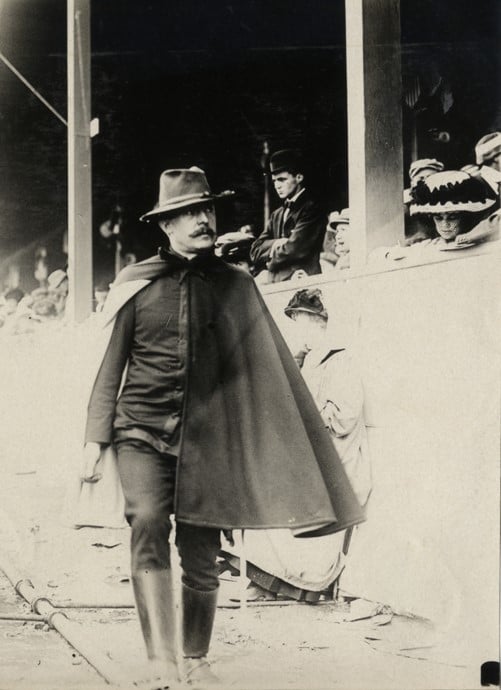
Colonel Crowley in front of the Grandstand
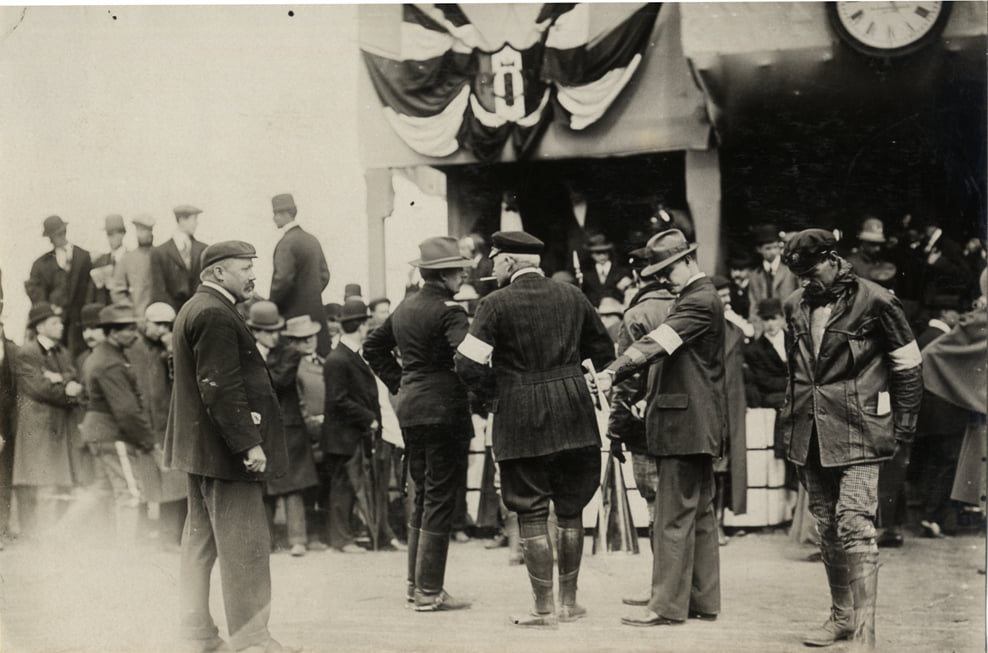
Chairman Jefferson De Mont Thompson, Sheriff Foster, Colonel Crowley and starter Fred J. Wagner.
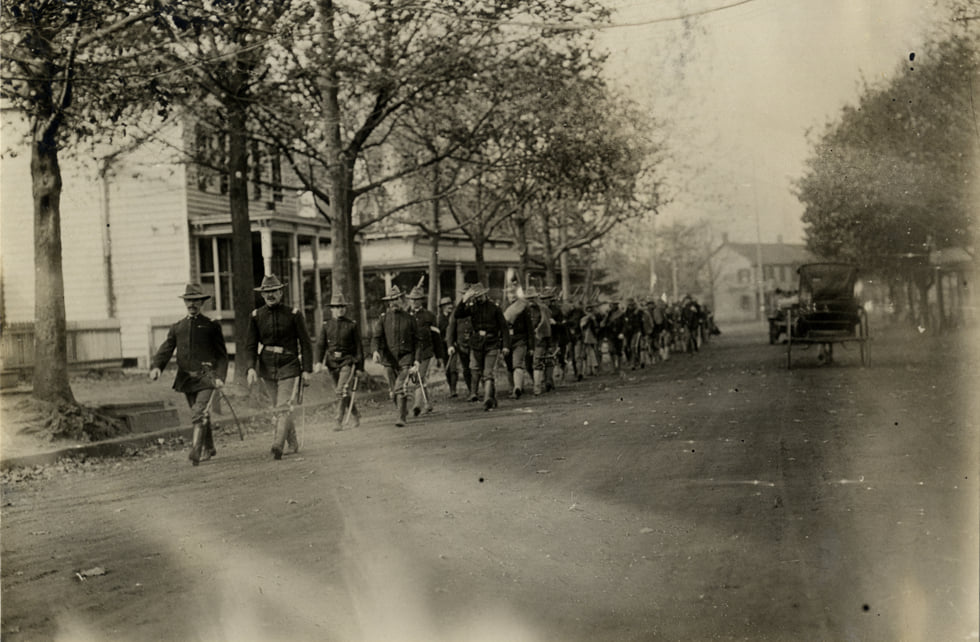
Irish Volunteers marching down a nearby road. Anyone with any guesses on location?
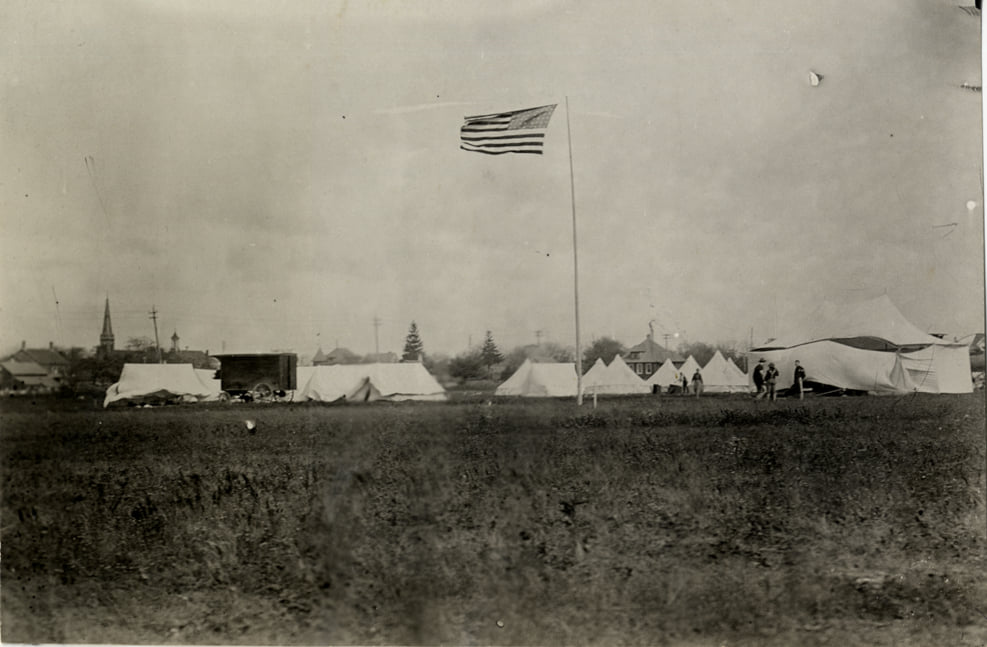
Irish Volunteers Encampment on Hempstead Plains 1908. Looking North/northeast.
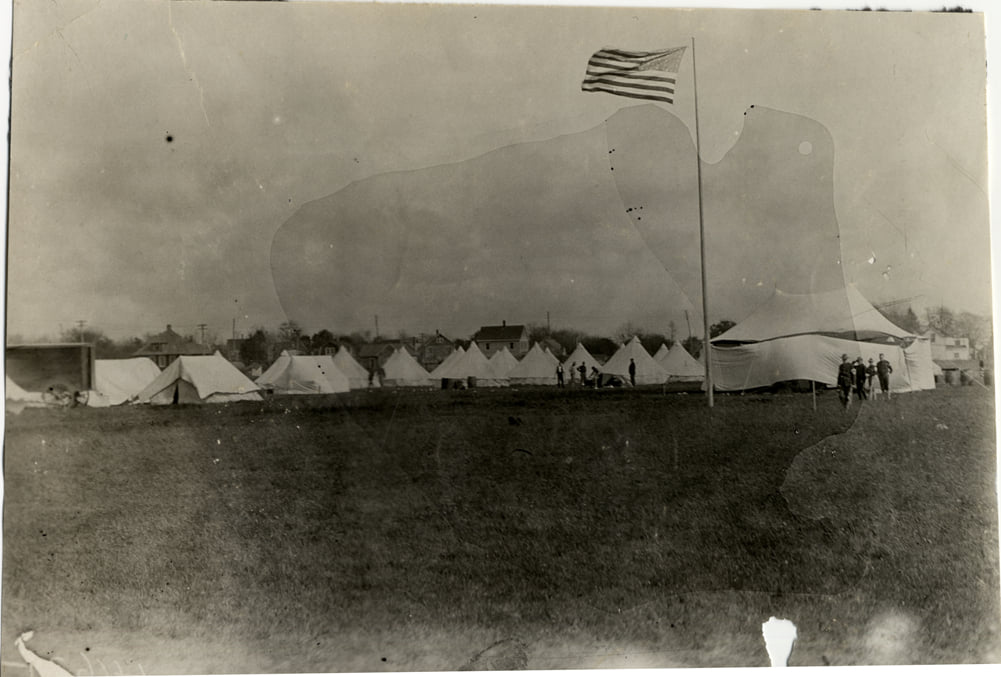
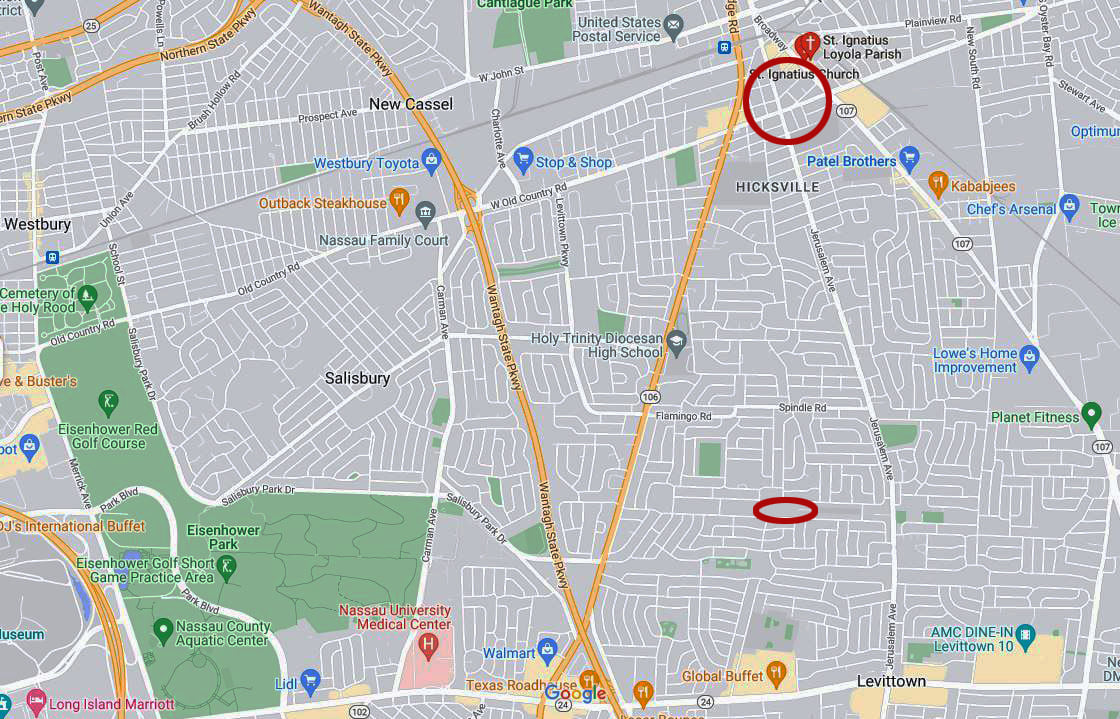
Google map with encampment area and grands stand circled and ovaled.
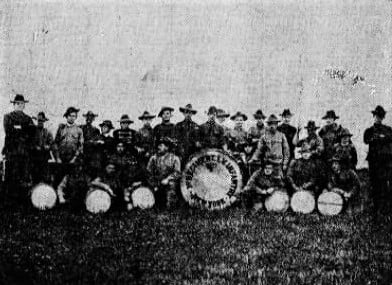
Irish Volunteers band
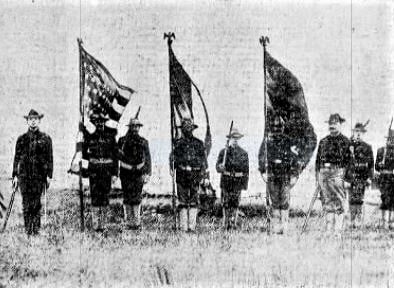
Irish Volunteers color guard
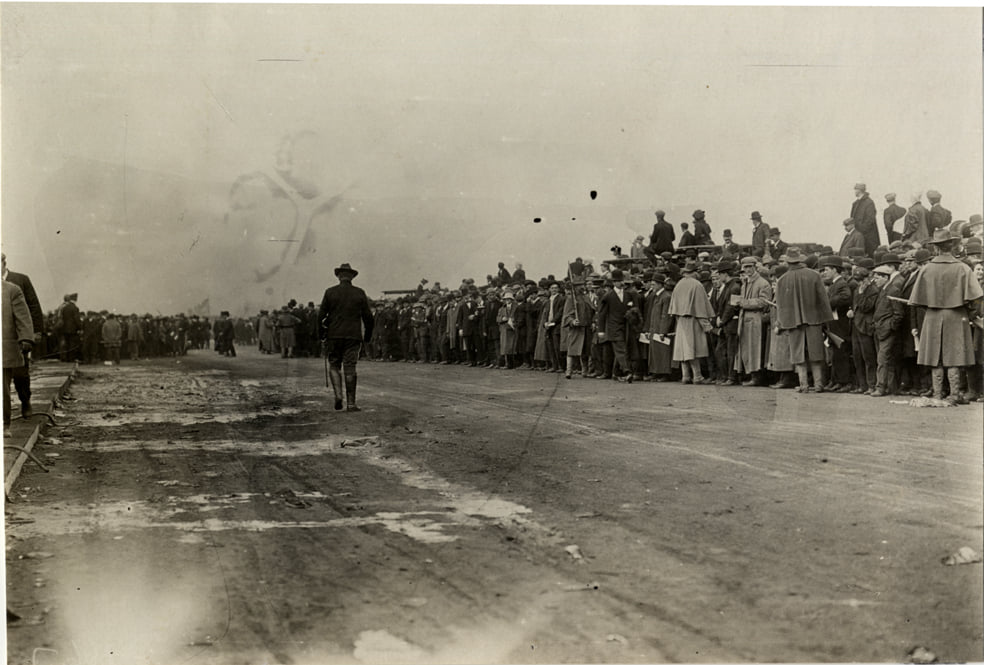
Irish Volunteers holding back the spectators from the roadway
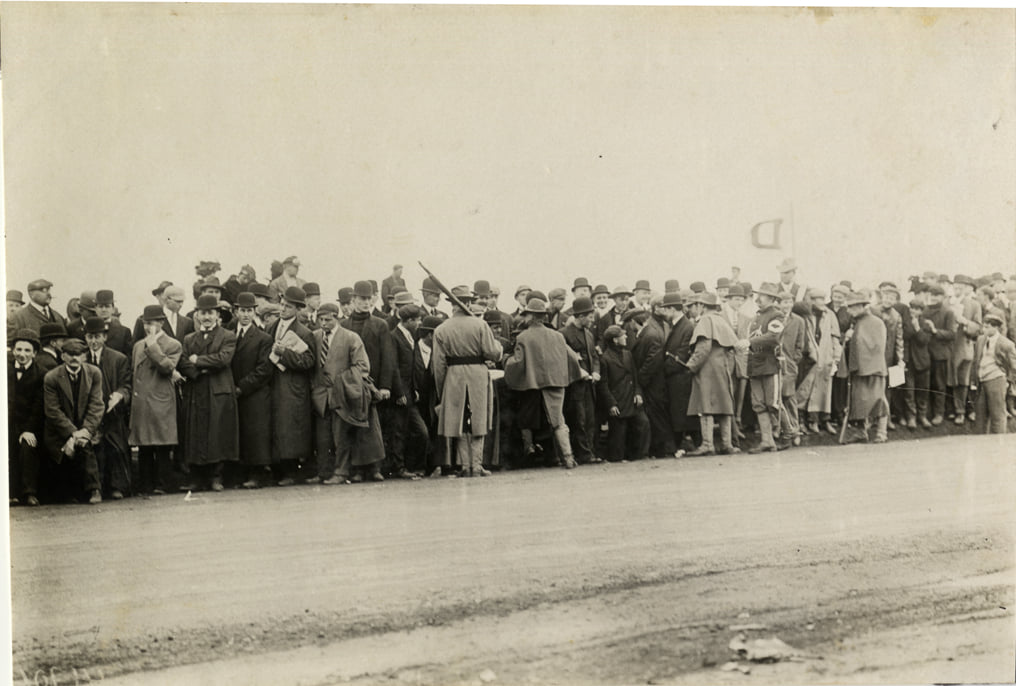
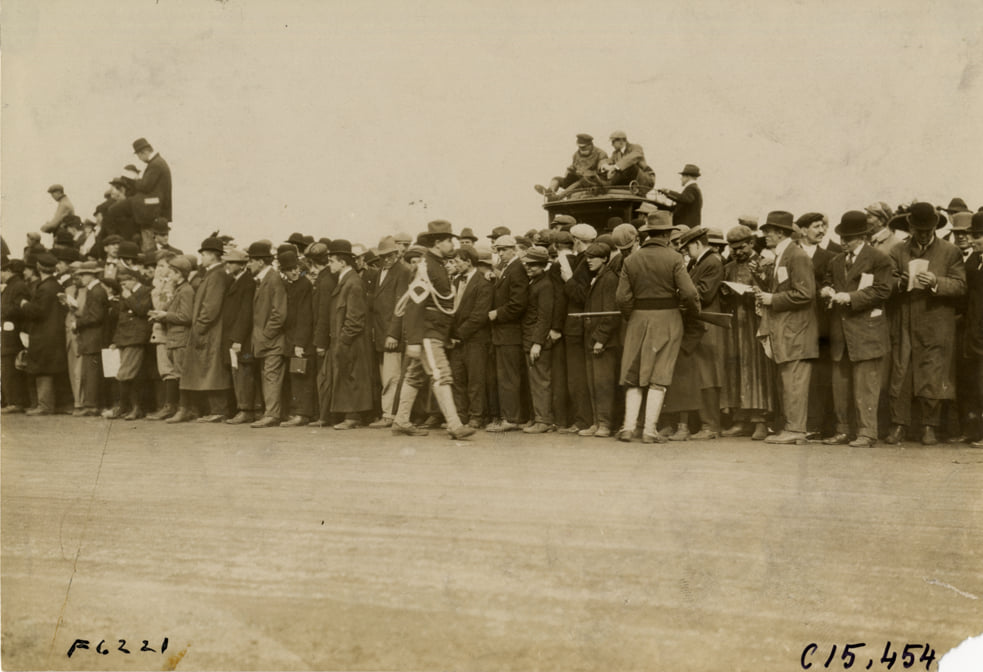
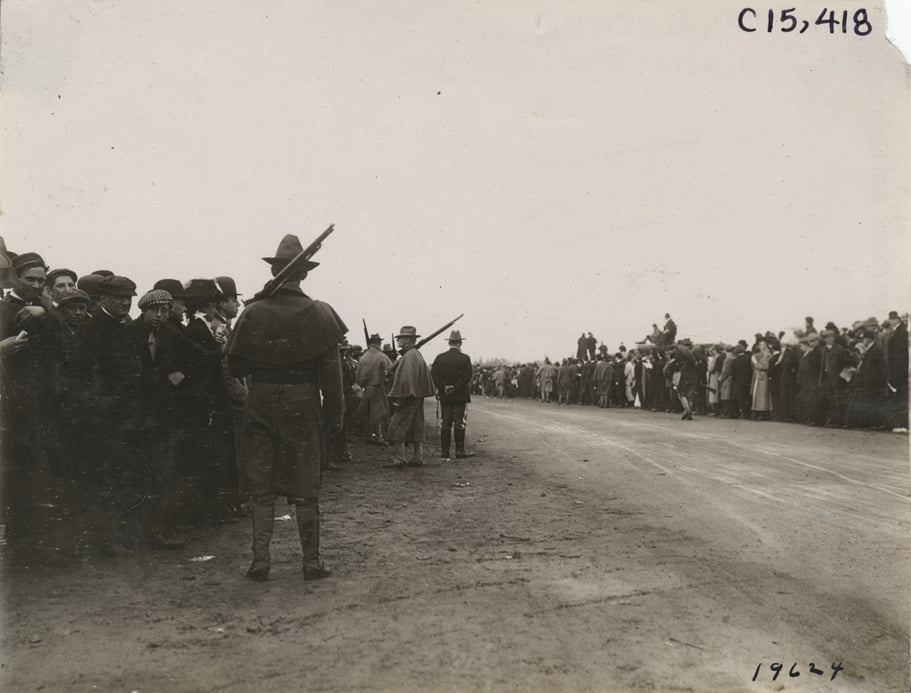

The Sunday morning Catholic Mass.
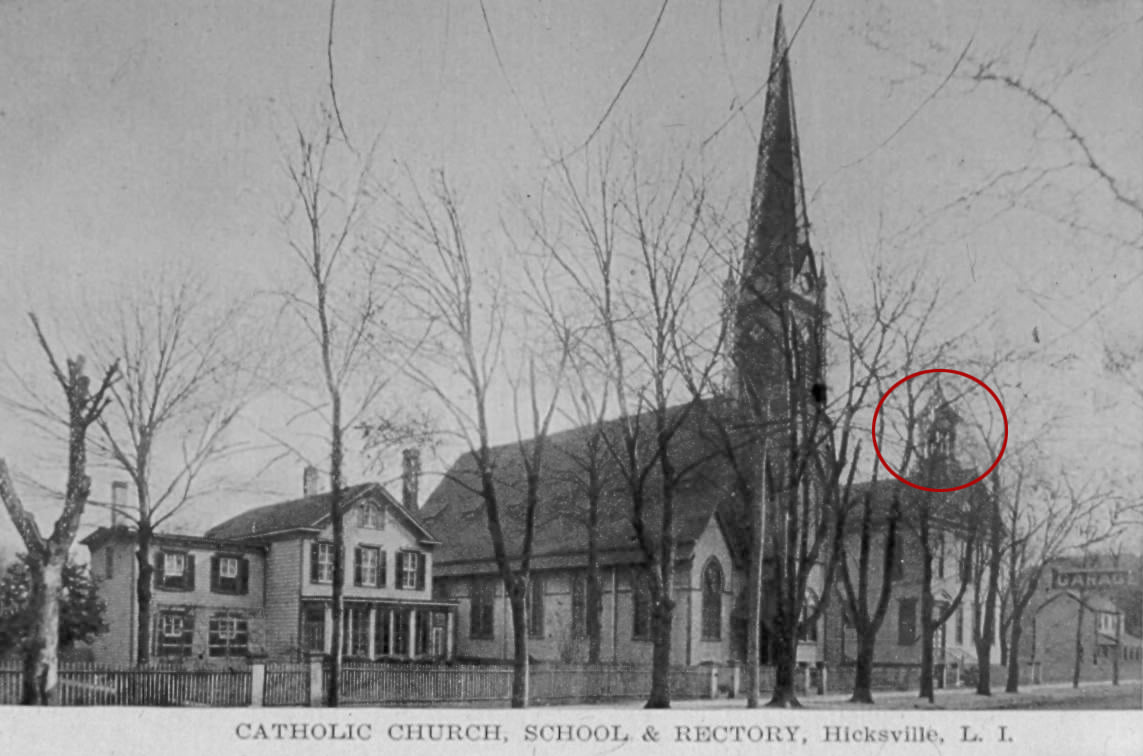
St. Ignatius Church. Looking south/southeast. Note smaller, lower steeple circled in red.
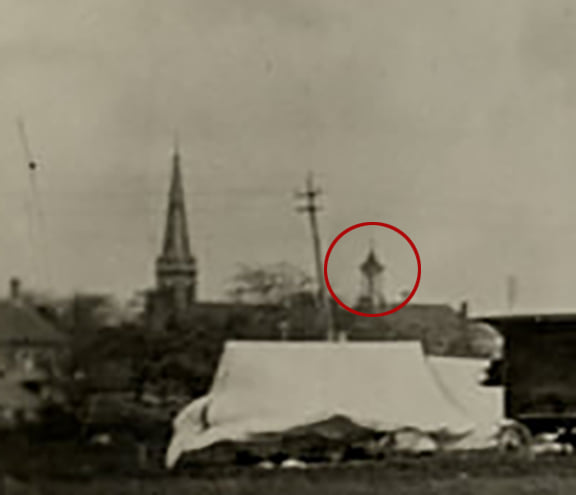
Enlargement of steeple. Looking north/northeast. Note smaller, lower steeple in red circle.
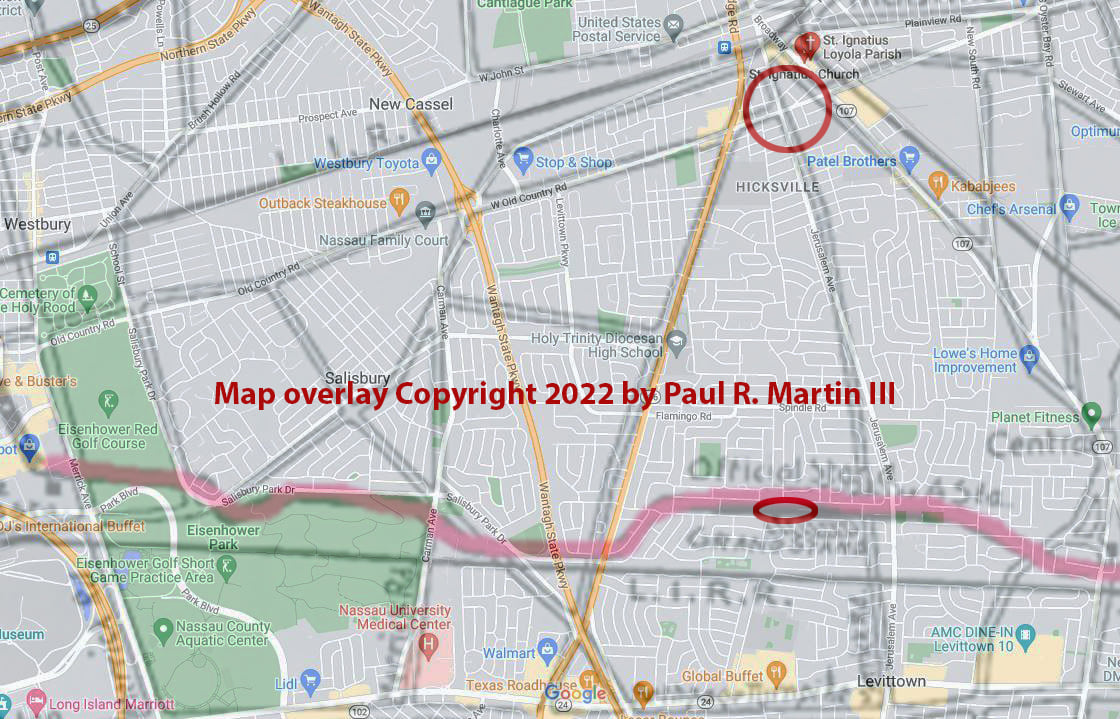
Google map with race course overlay.









Comments
Loved this little slice of Vanderbilt Cup history. Hard to imagine a modern day race having such a terrible time with crowd control. Imagine the Formula 1 races in Miami or Las Vegas with spectators wandering out into the middle of the course!